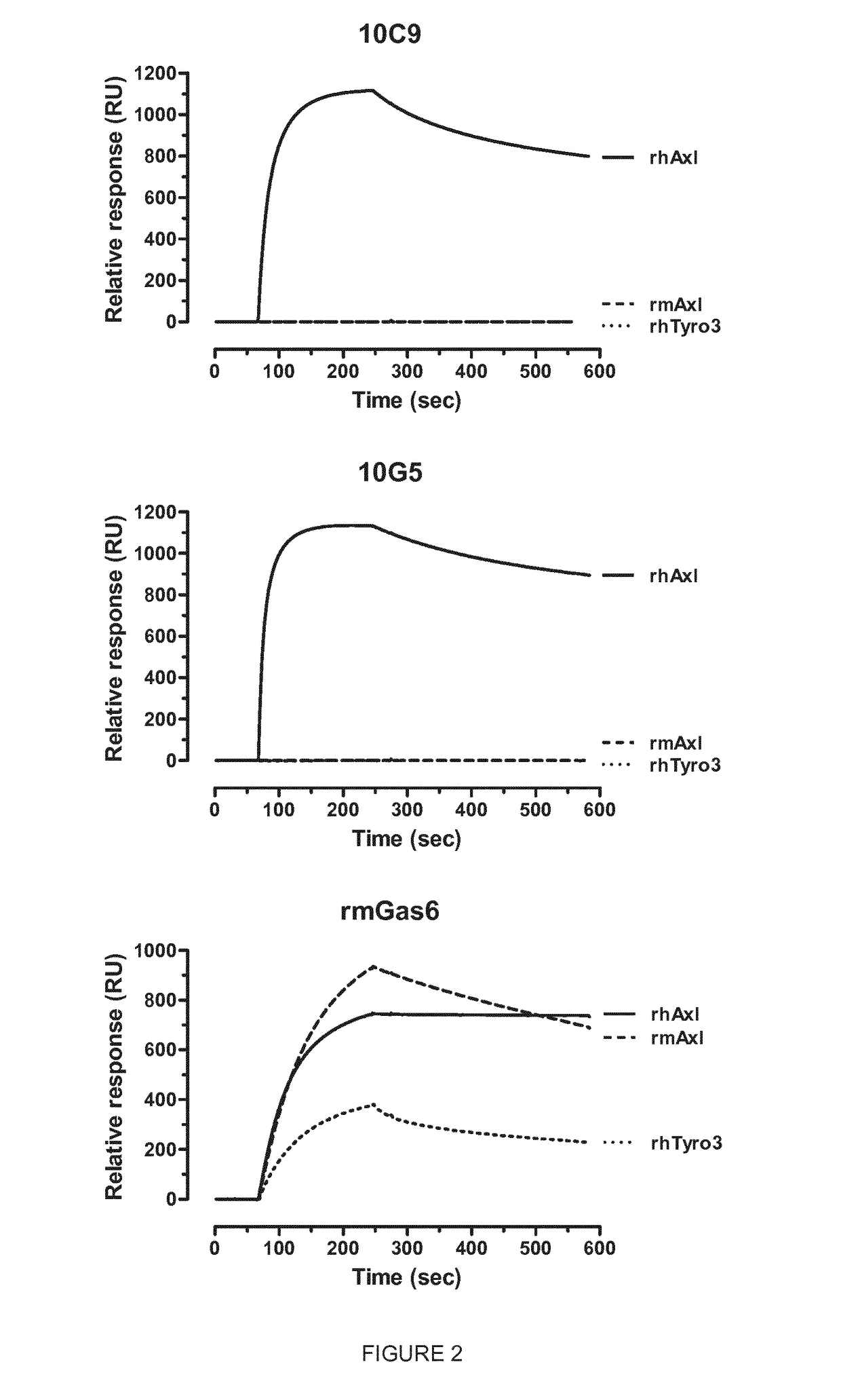Anti-Axl antagonistic antibodies
a technology of anti-axl and antagonists, applied in the field of anti-axl antagonistic antibodies, can solve problems such as poor prognosis, and achieve the effect of attenuating the growth of a549 tumours
- Summary
- Abstract
- Description
- Claims
- Application Information
AI Technical Summary
Problems solved by technology
Method used
Image
Examples
example 1
n of Mouse Anti-Axl Monoclonal Antibodies
[0571]Monoclonal antibodies (MAb) against human Axl receptor were generated by DNA immunization of immunocompetent NMRI mice (Charles River) with a plasmid encoding a full-length human Axl fused to C-terminal Myc epitope.
[0572]Spleen cells from mice showing presence of rhAxl-specific antibodies in the blood were used for fusion with mouse myeloma cells according to standard protocols. The cells were cultured in plates (105 cells per well) with hypoxanthine-aminopterin-thymidine (HAT) medium for hybridoma selection. After twelve days of selection, the supernatants of 14 generated hybridomas were harvested and tested for Axl binding in enzyme-linked immunosorbent assay (ELISA) and flow cytometry. Three positive clones, showing the highest antigen-binding activity after the second round of subcloning by limited dilution, were expanded for large scale antibody production in vitro. The MAbs were purified from the cell culture supernatants by Prote...
example 2
oclonal Antibodies 10C9 and 10G5 do not Cross-React with Other Members of Human TAM Receptor Family
[0576]All binding experiments were performed using Biacore 3000 instrument (GE Healthcare) at 25° C. Soluble recombinant antigens corresponding to the extracellular domains of members of the human TAM receptor family, Axl (rhAxl-Fc chimera; R&D Systems, Cat. no. 154-AL), Mer (rhMer-Fc chimera; R&D Systems, Cat. no. 891-MR) and Tyro3 (rhTyro3 / Dtk-Fc chimera; R&D Systems, Cat. no. 859-DK) were immobilized on the surface of CM5 sensor chip using amine coupling at the surface density of 393.0, 303.6 and 364.0 resonance units (RU), respectively. The Biacore run was performed in an automatic mode using Binding analysis wizard. Samples containing either MAb 10C9 or MAb 10G5 at concentration 10 μg / mL in HBS-EP buffer (GE Healthcare) were injected over the surfaces with immobilized antigens at flow rate of 30 μL / min for 3 min (association) followed by 5 min dissociation.
[0577]The results shown ...
example 3
oclonal Antibodies 10C9 and 10G5 do not Cross-React with Mouse Axl
[0578]The binding experiments were performed using Biacore 3000 instrument (GE Healthcare) at 25° C. The soluble recombinant antigens corresponding to human Axl (rhAxl-Fc chimera; R&D Systems, Cat. no. 154-AL), mouse Axl (rmAxl-Fc chimera; R&D Systems, R&D Systems; Cat. no. 854-AX) and human Tyro3 (rhTyro3 / Dtk-Fc chimera; R&D Systems, Cat. no. 859-DK) were immobilized on the surface of CM5 sensor chip using amine coupling at the surface density of 1,308.0, 2,115.9 and 1,429.0 RU, respectively. The Biacore runs were performed in an automatic mode using Binding analysis wizard.
[0579]The sample containing either MAb 10C9, MAb 10G5 or recombinant mouse (rm) Axl-ligand Gas6 (R&D Systems, Cat. no. 986-GS / CF) at concentration 10 μg / mL in HBS-EP buffer (GE Healthcare) was injected over the surfaces with immobilized antigens at flow rate of 30 μL / min for 3 min (association) followed by 5 min dissociation.
[0580]The results show...
PUM
| Property | Measurement | Unit |
|---|---|---|
| width | aaaaa | aaaaa |
| molecular weight | aaaaa | aaaaa |
| diameter | aaaaa | aaaaa |
Abstract
Description
Claims
Application Information
 Login to View More
Login to View More - R&D
- Intellectual Property
- Life Sciences
- Materials
- Tech Scout
- Unparalleled Data Quality
- Higher Quality Content
- 60% Fewer Hallucinations
Browse by: Latest US Patents, China's latest patents, Technical Efficacy Thesaurus, Application Domain, Technology Topic, Popular Technical Reports.
© 2025 PatSnap. All rights reserved.Legal|Privacy policy|Modern Slavery Act Transparency Statement|Sitemap|About US| Contact US: help@patsnap.com



